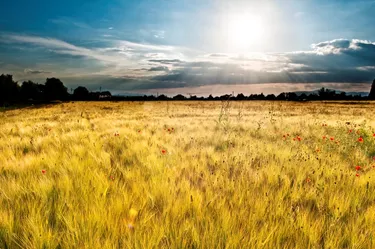
Whether you want to buy a small farm in the country, finance a home in a rural setting or simply buy a plot of land for a future getaway, you have several options for rural financing. Besides local lenders at small town banks, the federal government has established several lending programs that focus on rural development in the form of personal and property loans.
Commercial Banks
Video of the Day
Commercial banks are the No. 1 source of rural financing, according to the United States Department of Agriculture (USDA) Economic Research Service. Included in this financing are home loans, farm loans, loans to small business owners and personal loans for the rural residents. Home mortgages make up the bulk of rural financing from commercial banks, following by farm loans.
Video of the Day
Home Financing
The USDA works with private lenders through its Rural Development program to help individuals and families with low and moderate incomes obtain home mortgages. In these programs, rural areas are considered those communities with 10,000 residents or less and open country areas. The Section 502 Loan Guarantee Program finances single-family homes, and the program guarantees up to 90 percent of the mortgage. These loans do not have to be used simply to purchase a new home. Instead, new builds, repairs, renovations and moves are also eligible for financing. Borrowers must be in need of adequate housing and capable of paying the mortgage and taxes and maintaining homeowners' insurance.
Farm Financing
The USDA Farm Service Agency (FSA) provides financing to farmers and rural residents across the nation through multiple loan programs. Commercial lenders nationwide participate. In addition, the Farm Credit System, a network of customer-owned cooperatives throughout the U.S., issues FSA-backed loans in its guaranteed loan program. In this program, the federal government protects the private lender should the borrower default on the loan. The FSA internally finances a separate direct loan program. The FSA also manages a land contract program that provides guarantees to land owners who sell property to beginning or socially disadvantaged farmers, such as those who have been victims of racial or ethnic discrimination. The seller can choose between two types of guarantees in case the buyer defaults. One is a prompt payment guarantee reimbursing the seller for three annual payments plus the cost of pertinent taxes and insurance. The other is a guarantee on 90 percent of the unpaid principal.
Farm Credit System
Besides participating in the FSA guaranteed loan program, the Farm Credit System lends money directly to individuals for land purchases, provides financing for equipment and operations and offers crop insurance. Farm Credit also has a program specifically for young, beginning and small farmers. Farm Credit categorizes a small farm as one with less than $250,000 in yearly production. Young farmers are considered those 35 or younger, and a beginning farmer is categorized as one with less than 10 years experience.
Emergency Funding
Through an FSA program, emergency loans are available to qualified rural residents. Farmers and ranchers who have suffered a loss resulting from a natural disaster may apply. The funds can be used for various needs, from repairing and replacing property to paying bills, including basis living expenses. Emergency loans are available for up to 100 percent of the loss or $500,000, whichever is less, and typically carry terms of one to seven years.